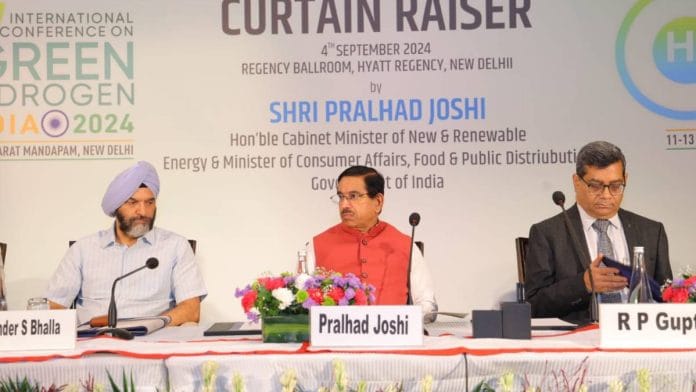New Delhi: India has already announced projects to produce 7.5 million metric tonnes (MMT) of green hydrogen per year, more than its target of 5 MMT by 2030, said Ministry of New and Renewable Energy (MNRE) Secretary Bhupinder Singh Bhalla Wednesday. He was speaking at the curtain-raiser for the 2nd International Conference on Green Hydrogen (ICGH).
Responding to a question, Bhalla said he was “100 percent” confident that India would meet the 2030 target for green hydrogen production, but did not go into the details of the projects announced or where they are housed.
Instead, Bhalla and MNRE Joint Secretary Ajay Yadav talked about how the National Green Hydrogen Mission of 2023, with a total outlay of Rs 19,744 crore, had already seen major developments. The electrolyser manufacturing incentives of Rs 4,400 crore and green hydrogen production incentives of Rs 13,050 crore have already been awarded to a total of 18 companies earlier this year, they said.
Additionally, the MNRE also released the research and development (R&D) roadmap for the production of green hydrogen in October last year, for which they have received more than 400 proposals from private players.
“India is soon going to be the aggressor in the production, export and utilisation of green hydrogen with its derivatives,” Pralhad Joshi, Minister of New and Renewable Energy, said at the event.
Green Hydrogen Conference
The second edition of the ICGH will be held at the Bharat Mandapam in New Delhi between 11 and 13 September, and host over 7,000 Indian and global delegates. For this year, the US has been chosen as a partner country for the conference, and bilateral discussions on R&D, technology and green hydrogen strategies will be a major part of the event.
Green hydrogen is produced using renewable energy sources and is used in power generation, transport, heavy industries, and chemical industries, such as the production of ammonia. At 6 million tonnes of hydrogen annually, India accounts for 9 percent of the global demand for hydrogen, which sits at 95 million tonnes, according to the International Energy Agency.
Right now, most of the hydrogen production uses fossil fuel sources, like coal or natural gas. By switching to renewable energy in hydrogen production, the hope is that India can reduce its greenhouse gas emissions, getting closer to achieving its target of net-zero emissions by 2070.
As compared to last year, this year’s conference will see more ministries and government bodies associated with it, including the Department of Science and Technology, the Office of the Principal Scientific Adviser, the Ministry of Petroleum and Natural Gas, and the Department of Scientific and Industrial Research, apart from the MNRE.
“India is already at an advantage to produce green hydrogen because we have very competitive renewable energy prices, an integrated grid, a youth talent pool, and a huge eastern and western coastline for green hydrogen ports,” Yadav said at the event.
The curtain-raiser event also saw MNRE officials talk about the incentives and benefits provided to the industry to increase the production of green hydrogen, including electricity duty and stamp duty benefits as well as exemptions from environment clearances for green hydrogen plants.
“The only way to attract young blood to the green hydrogen industry is by incentivising start-ups to join us—this will make India the global leader in green hydrogen,” concluded Joshi in his address.
(Edited by Sanya Mathur)
Also Read: Gujarat flooded, eastern India parched & no ‘monsoon breaks’. IMD predictions hit the mark






